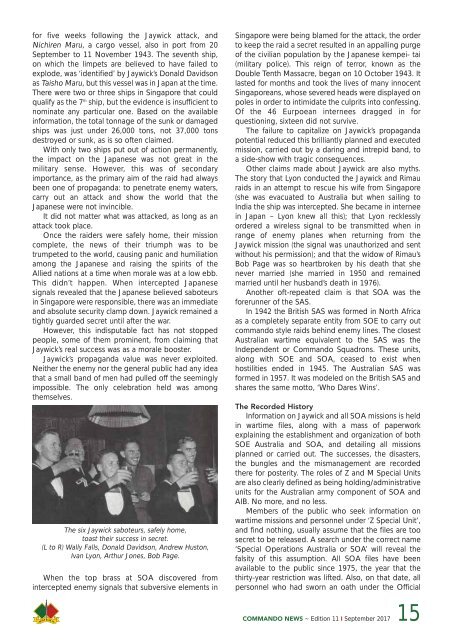Commando News Spring17
You also want an ePaper? Increase the reach of your titles
YUMPU automatically turns print PDFs into web optimized ePapers that Google loves.
for five weeks following the Jaywick attack, and<br />
Nichiren Maru, a cargo vessel, also in port from 20<br />
September to 11 November 1943. The seventh ship,<br />
on which the limpets are believed to have failed to<br />
explode, was ‘identified’ by Jaywick’s Donald Davidson<br />
as Taisho Maru, but this vessel was in Japan at the time.<br />
There were two or three ships in Singapore that could<br />
qualify as the 7 th ship, but the evidence is insufficient to<br />
nominate any particular one. Based on the available<br />
information, the total tonnage of the sunk or damaged<br />
ships was just under 26,000 tons, not 37,000 tons<br />
destroyed or sunk, as is so often claimed.<br />
With only two ships put out of action permanently,<br />
the impact on the Japanese was not great in the<br />
military sense. However, this was of secondary<br />
importance, as the primary aim of the raid had always<br />
been one of propaganda: to penetrate enemy waters,<br />
carry out an attack and show the world that the<br />
Japanese were not invincible.<br />
It did not matter what was attacked, as long as an<br />
attack took place.<br />
Once the raiders were safely home, their mission<br />
complete, the news of their triumph was to be<br />
trumpeted to the world, causing panic and humiliation<br />
among the Japanese and raising the spirits of the<br />
Allied nations at a time when morale was at a low ebb.<br />
This didn’t happen. When intercepted Japanese<br />
signals revealed that the Japanese believed saboteurs<br />
in Singapore were responsible, there was an immediate<br />
and absolute security clamp down. Jaywick remained a<br />
tightly guarded secret until after the war.<br />
However, this indisputable fact has not stopped<br />
people, some of them prominent, from claiming that<br />
Jaywick’s real success was as a morale booster.<br />
Jaywick’s propaganda value was never exploited.<br />
Neither the enemy nor the general public had any idea<br />
that a small band of men had pulled off the seemingly<br />
impossible. The only celebration held was among<br />
themselves.<br />
The six Jaywick saboteurs, safely home,<br />
toast their success in secret.<br />
(L to R) Wally Falls, Donald Davidson, Andrew Huston,<br />
Ivan Lyon, Arthur Jones, Bob Page.<br />
When the top brass at SOA discovered from<br />
intercepted enemy signals that subversive elements in<br />
Singapore were being blamed for the attack, the order<br />
to keep the raid a secret resulted in an appalling purge<br />
of the civilian population by the Japanese kempei- tai<br />
(military police). This reign of terror, known as the<br />
Double Tenth Massacre, began on 10 October 1943. It<br />
lasted for months and took the lives of many innocent<br />
Singaporeans, whose severed heads were displayed on<br />
poles in order to intimidate the culprits into confessing.<br />
Of the 46 Eurpoean internees dragged in for<br />
questioning, sixteen did not survive.<br />
The failure to capitalize on Jaywick’s propaganda<br />
potential reduced this brilliantly planned and executed<br />
mission, carried out by a daring and intrepid band, to<br />
a side-show with tragic consequences.<br />
Other claims made about Jaywick are also myths.<br />
The story that Lyon conducted the Jaywick and Rimau<br />
raids in an attempt to rescue his wife from Singapore<br />
(she was evacuated to Australia but when sailing to<br />
India the ship was intercepted. She became in internee<br />
in Japan – Lyon knew all this); that Lyon recklessly<br />
ordered a wireless signal to be transmitted when in<br />
range of enemy planes when returning from the<br />
Jaywick mission (the signal was unauthorized and sent<br />
without his permission); and that the widow of Rimau’s<br />
Bob Page was so heartbroken by his death that she<br />
never married (she married in 1950 and remained<br />
married until her husband’s death in 1976).<br />
Another oft-repeated claim is that SOA was the<br />
forerunner of the SAS.<br />
In 1942 the British SAS was formed in North Africa<br />
as a completely separate entity from SOE to carry out<br />
commando style raids behind enemy lines. The closest<br />
Australian wartime equivalent to the SAS was the<br />
Independent or <strong>Commando</strong> Squadrons. These units,<br />
along with SOE and SOA, ceased to exist when<br />
hostilities ended in 1945. The Australian SAS was<br />
formed in 1957. It was modeled on the British SAS and<br />
shares the same motto, ‘Who Dares Wins’.<br />
The Recorded History<br />
Information on Jaywick and all SOA missions is held<br />
in wartime files, along with a mass of paperwork<br />
explaining the establishment and organization of both<br />
SOE Australia and SOA, and detailing all missions<br />
planned or carried out. The successes, the disasters,<br />
the bungles and the mismanagement are recorded<br />
there for posterity. The roles of Z and M Special Units<br />
are also clearly defined as being holding/administrative<br />
units for the Australian army component of SOA and<br />
AIB. No more, and no less.<br />
Members of the public who seek information on<br />
wartime missions and personnel under ‘Z Special Unit’,<br />
and find nothing, usually assume that the files are too<br />
secret to be released. A search under the correct name<br />
‘Special Operations Australia or SOA’ will reveal the<br />
falsity of this assumption. All SOA files have been<br />
available to the public since 1975, the year that the<br />
thirty-year restriction was lifted. Also, on that date, all<br />
personnel who had sworn an oath under the Official<br />
COMMANDO NEWS ~ Edition 11 I September 2017 15

















